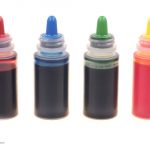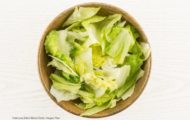D-LO's Gourmet Pistachio Cheesecake is being recalled because it may contain wheat and soy, along with food dyes Yellow #5 and Blue #1 that are not declared on the label as required by law. Anyone who is allergic to those ingredients could have a serious reaction if they eat this product. Because this recall notice was posted on the FDA's Enforcement Reports page, and not the regular recall page, there is no mention about whether or not any adverse reactions have been reported to date. The recalling firm is D-lo's Gourmet Cheesecake of Detroit, Michigan. The recalled product was sold in the state of Michigan at the retail level. The recalled item is D-LO's Delightful Gourmet Cheesecake in Pistachio flavor. The product is packaged in a clear plastic container with a hinged lid that … [Read more...]
California Bans Red 3, Brominated Vegetable Oil, Other Additives
California bans Red 3, brominated vegetable oil, potassium bromate, and propylparaben from being added to food because of possible adverse health effects. The governor signed the legislation on October 7, 2023. Industry has until 2027 to comply with this new law. The synthetic dye, Red 3, is made from petroleum. The law, Assembly Bill 418, makes California the first state in the country to ban the use of these additives in packaged foods. The FDA says they are safe to consume. Center for Science in the Public Interest (CSPI) states that the FDA learned Red 3 was a carcinogen in the 1980s and declared it as a carcinogen in 1990. This 2012 article from The National Library of Medicine states that Red 3 causes cancer in animals. The FDA has eliminated the use of this food dye from … [Read more...]
F-Bombs Truffles Recalled For Undeclared Yellow Dyes
F-Bombs Truffles are being recalled because they contain undeclared Yellow #5 and Yellow #6, two food dyes. People who are sensitive to those dyes could experience hives, itching, coughing, vomiting, swelling of the lips, tongue, throat, and neck, and asthma-like symptoms if they eat these products. There is no mention of any reactions because this recall was posted on the FDA's Enforcement Reports page and not the regular recall page. The recalling firm is Fox Confections LLC Of Mentor, Ohio. The truffles were distributed to 90 retail locations in Illinois and Ohio. The recalled products are all F-Bombs Truffles brand. The recalled products include Original Truffles packaged in 12 ounce plastic packaging. The product number is 01800. Also recalled is Peanut Butter Truffles in 12 … [Read more...]
Long Term Consumption of Allure Red Food Dye Can Trigger IBD
A study from McMaster University has found that the long term consumption of Allura Red food dye can trigger IBD (inflammatory bowel diseases), Crohn's disease, and ulcerative colitis. Researcher Waliul Khan, a professor of the Department of Pathology and Molecular Medicine and a principle investigators of Farncombe Family Digestive Health Research Institute, used experimental animal models of IBD to conduct the study. The study's first author is Yan Han (Eric) Kwon. Inflammatory bowel diseases have been increasing over the last ten years, according to the National Institutes of Health. Those diseases are usually attributed to a "Westernized" lifestyle, including high fat foods with little fiber. The researchers found that continual exposure to Allura Red AC damages gut health … [Read more...]
Most Kids Exposed to Food Dyes
The Food and Drug Administration has found that 96% of children age 2 to 5 years are exposed to food dyes. Center for Science in the Public Interest petitioned the FDA in 2008 asking to ban eight of the nine certified color additives. CSPI senior scientist Lisa Y. Lefferts said in a statement, "such widespread exposure to artificially colored foods is bad news for all children, since artificially colored foods aren't healthy foods in the first place. The FDA is failing kids and parents by allowing the use of these purely cosmetic chemicals in food, which trigger behavioral problems in some children, as even FDA conceded in 2011." The full results of the exposure assessment have not been published. The assessment was based on the amount of color additives in almost 600 food products … [Read more...]
First Study of Its Kind Reveals Food Dyes in Brand Name Products
A new study conducted at Purdue University that has been published in the journal Clinical Pediatrics reports on the dye content of many processed foods. The Center for Science in the Public Interest (CSPI) states that the findings are "disturbing since the amounts of dyes found in even single servings of numerous foods - or combinations of several dyed foods - are higher than the levels demonstrated in some clinical trials to impair some children's behavior." Artificial colors are used in many beverages, foods, snack foods, and sweets in the U.S. The FDA limits the colors allowed in our foods to nine different types. Studies have shown that these chemicals can affect children's behavior. The amount of food dyes that are certified has risen from 12 mg per person per day in 1950 to 62 mg … [Read more...]
Spring Celebration Egg Food Safety Advice
The folks at FightBac.org are offering some tips for keeping your food safe during spring celebrations. Easter and Passover feature lots of eggs, which can be contaminated with Salmonella bacteria, especially Salmonella enteritidis. Clean hands are key. Always wash your hands with soap and warm water for 20 seconds before and after food handling. Be careful about cross-contamination. Always wash utensils, food contact surfaces, cooking equipment, blenders, cutting boards, etc. in hot water and soap between uses. Since bacteria grow in moist, protein-rich foods, always refrigerate eggs and foods made with egg. Make sure your refrigerator is set at 40°F or below, and always use a refrigerator thermometer to monitor the temperature. Remember the two hour rule: after two hours, … [Read more...]











